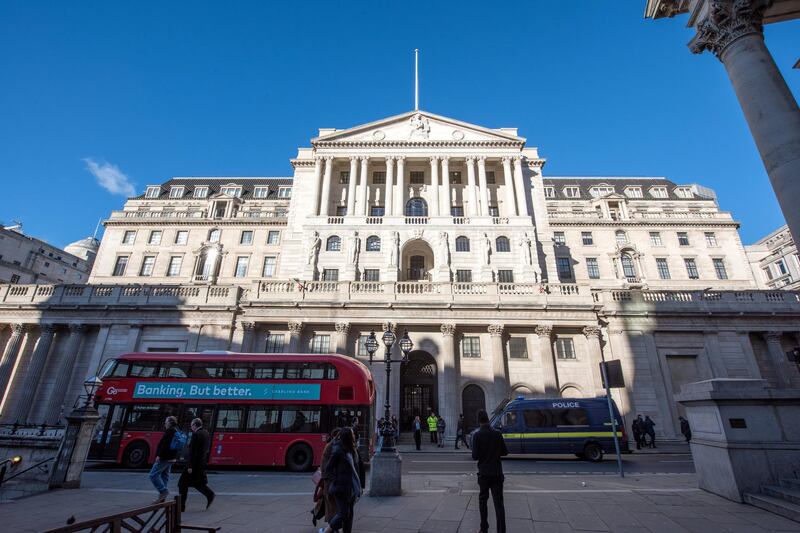In the course of its 325-year history, the Bank of England has acquired several nicknames. The most famous is “The Old Lady of Threadneedle Street”. This sobriquet was coined in an 18th-century cartoon by James Gillray, which depicted the institution as an elderly woman being manipulated by the prime minister, William Pitt the Younger.
The curator of a new exhibition at the bank told me that the sketch showed Pitt pretending to befriend the Old Lady, so she would give him money to support his armies in overseas wars.
The exhibit opens on Monday and, for me, its main takeaway is the institution’s sometimes ruthless defence of the wealth of the nation when the worst happens.
It is well timed, coming amid a growing sense that more trouble is just around the corner. Ominous economic and political clouds are not confined to Britain alone, but, owing to Brexit and the ongoing political infighting that has plagued Westminster since the UK's 2016 European Union membership referendum, the Bank of England faces especially heavy weather. Small wonder that two big-name targets to take over from Mark Carney as governor have refused to even make an application.
Original artefacts document past turmoil. One telegram dates from 1931, when Britain decided to abandon the gold standard, a monetary system in which a country's cash has a value directly linked to that of the precious metal.
Montagu Norman, then governor of the bank, was sailing across the Atlantic Ocean at the time and was informed in a cryptic note that the “Old Lady goes off on Monday”. So obscured was the message that Norman only realised its meaning when he saw newspaper billboards as he stepped ashore at Liverpool docks.
Perhaps the most drastic actions by the Bank came in late July and early August 1914, when the exchange of paper notes for gold sovereigns was halted. The outbreak of the First World War caught the economic planners on the hop. As queues formed, a four-day bank holiday was declared to take the pressure off. The Stock Exchange was also suspended, and trading was not resumed until November that year.
From the South Sea bubble – a rash of international speculation that ruined many British investors in 1720 – the Bank of England has had to cope with regular upheavals. Throughout, it has performed vital tasks, including the setting of interest rates, the supervision of financial institutions, the storing of gold for many nations in its vaults and the supply of banknotes.
The rise of a cashless economy does not diminish the relevance of the lessons the bank has learnt throughout its history. It also underwent a generational test in the 2008 financial crunch. Alongside the Federal Reserve, the Bank of Japan and the European Central Bank, the Bank of England pumped vast cascades of new money into the economy, in a strategy known as quantitative easing.
At best, the extra spending stopped the rot and aided a fragile recovery.
The political effect of 2008 revolves around the shattering of faith in the liberal economic model championed by Margaret Thatcher and Ronald Reagan. The rise of populism in subsequent years is best demonstrated by the 2016 Brexit vote and the election of President Donald Trump in the US. However, the trend goes wider than the Anglosphere.
Six European nations have since voted in populist governments or coalitions containing once-marginalised political forces. The Mena region continues to reverberate with the effects of previous popular uprisings.
In the latest update to his book The Ascent of Money, the right-wing historian Niall Ferguson cites the Stanford political scientist Larry Diamond, who has said that, in the past decade, the world has experienced a "democratic recession".
This trend is inexorably leading towards an economic recession. Figures based on International Monetary Fund estimates released this week gave new forecasts of a damaging downturn, including an annualised £30 billion hit to the national budget, should the UK pursue a no-deal Brexit in October.
World Trade Organisation figures project global trade growth of just 2.6 per cent, compared with an 8 per cent average a decade ago. With China and the US locked in a trade war, shipping indices are flashing red, with the largest US freight operators making profit warnings last week. The New York Federal Reserve estimates a one-third risk of recession in the next 12 months – a very strong likelihood.
If the Bank of England planners tour the public museum, one conclusion is the character of each crisis is always different. One of the 325 exhibits is a new origami artwork of a tree made from shocking-pink £50 notes.
A thing of beauty for insiders to contemplate if, or almost certainly when, the governor battens down the hatches to get through the next crisis.





